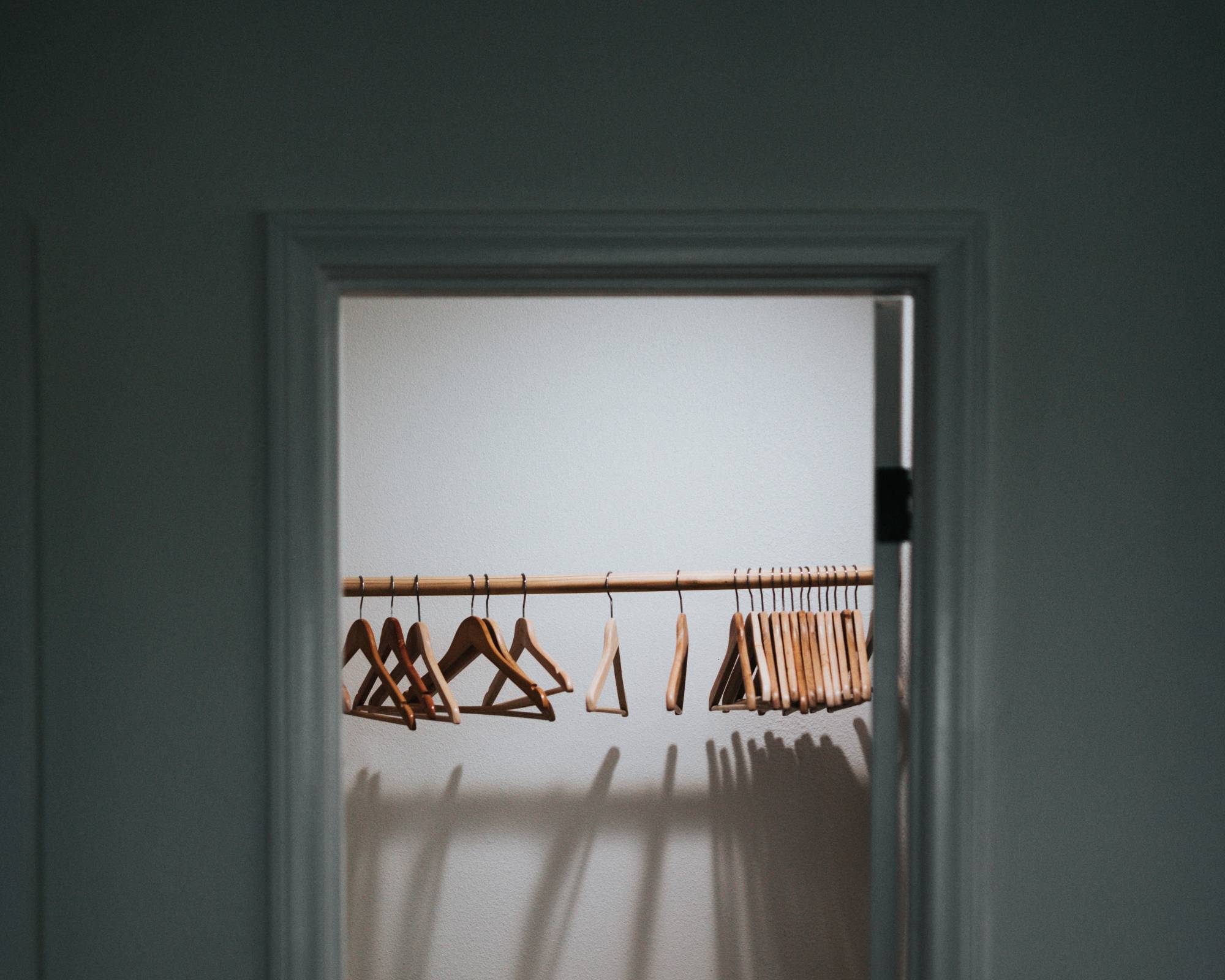Decluttering our closets may just be the key to unlocking a more sustainable and mindful approach to fashion. Whether you’re looking to reduce your wardrobe, make more conscious fashion choices, or simply tidy your closet, this step-by-step guide to cleaning out your wardrobe has everything you need to get started.
Less is more
We all know the feeling of standing in front of a closet full of clothes but feeling like we have nothing to wear. The truth is, we often have plenty to wear, and most of us have more clothes than we need or even wear.
Cleaning out your closet regularly is a great way to take stock and organise what you have. It allows you to make the most out of what you have more easily, which is often the most sustainable thing you can do to reduce the impact of your fashion choices.
Our editors have put together this step-by-step guide to cleaning out your closet and making more mindful fashion choices. From dealing with the unwanted pile to organising the items you decide to keep, we’ll walk you through every step of the process. Let’s get started.
Prep your space and make a plan
Getting organised is a crucial step in cleaning out your wardrobe and one that can make the task feel less daunting.
To begin, set aside a dedicated block of time to focus solely on the task at hand. Clear out everything that might be in the way and free up space so you can be efficient.
Next, gather supplies such as boxes, hangers, and bags for sorting items. Having these items on hand will make it easier to organise your clothes and keep track of what you plan to do with each piece of clothing (more on that later).
Finally, create a plan for what to do with clothes you want to sell, donate, swap, or keep. This will give you a clearer sense of purpose and direction.
Take everything out (yes, everything)
Now that you have your plan and supplies, it’s time to take everything out and start getting down to the nitty-gritty.
Marie Kondo, world renowned organising consultant and author (you might know her for her bestselling book The Life-Changing Magic of Tidying Up or her Netflix series), recommends taking everything out of your closet—and she means everything. Clothes, shoes, accessories—you name it, get it out of there.
This part might be daunting, but don’t worry; we promise it’ll all fit back in when you’re done.
Once you’ve got everything out on the floor or your bed, sort items into categories such as tops, bottoms, dresses, etc. You could sort by seasons or styles to hone in on what you have if you prefer.
Starting from scratch is both liberating and terrifying, but trust us, you’ll feel a hundred times better after saying goodbye to those old, ratty socks that have been hiding at the back of your wardrobe for way too long.
Separate into piles
You’ve taken everything out of your wardrobe and sorted them into categories, now what? Sort your items into piles for keep and unwanted items. One way to know whether or not you should keep an item is to follow the Marie Kondo method and ask yourself the question that’s become a meme: “Does this item spark joy?”.
Trying the clothes sometimes makes it easier to get a better idea of how they make you feel and if they still fit. Take pictures and ask for a second opinion if needed. Don’t be afraid to shop your own closet and have a styling session. Trying an item you had forgotten about can help you learn more about your personal style and discover some hidden gems. And remember to document your discoveries.
If an item doesn’t “spark joy”, doesn’t fit you, or hasn’t been worn in over a year, it’s time to consider rehoming or reselling it. Trust us, it’ll feel so satisfying to see those piles grow as you free up space and make room for pieces that truly bring you joy.
A note on the KonMari method
You’d have to be living under a rock to miss Kondo’s influence on pop culture in recent years. But her advice is far from trivial. Her KonMari method revolves around the idea that the items you own should bring you joy, and if they no longer serve this purpose, you should let them go (but do so responsibly, of course—more on that below). Belongings are acknowledged for their service and thanked before being sent on their merry way. People are drawn to this philosophy not only due to its effectiveness but also because it places great importance on being mindful, introspective, and optimistic. If it works for you, great. If not, take it or leave it.
Dealing with the unwanted pile
Next, let’s tackle the items you no longer want or need. The one thing you should not do is throw these items in the trash.
Unfortunately, in most countries, there is no simple mechanism for recycling clothing. Unlike many glass or recyclable plastic containers that are sorted, bailed, and re-used, clothes left in your kerbside bins simply end up in landfill.
The best options are almost always to sell, swap, donate, upcycle, or recycle. Let’s find new homes and purposes for your items.
Selling or swapping gently used clothes
If your clothes are in good condition or just gently worn out, consider selling them. Not only will you give these items a new lease on life, but you’ll also make some extra cash. It’s a win-win. The good news is that selling second hand goods is easier and more accessible than ever.
As you sort through your unwanted pile, look up listings for similar pre-loved pieces, whether they’ve recently sold, and the price range. This will help you decide what’s appealing to used clothing buyers. Check out our tips and favourite online platforms for selling second hand clothes.
Swapping is another way you can mindfully deal with the clothes that no longer have a place in your wardrobe. Swapping something out with a friend every few months will give you a sense of novelty while also supporting your friends to reduce and reuse as well.
Donating
There’s a common misconception that donating unwanted clothes is better for the environment and people in need. But that’s not entirely true.
Particularly in affluent Western countries, shoppers now consume cheap, low-quality fashion at such a fast rate that charities and op-shops can barely begin to deal with the vast amounts of clothes being dumped on them.
Not only is the sheer volume of clothing a major issue, but the declining quality of donated clothes means that many of these are unsalable and end up in landfills anyway. To make matters worse, according to a report by the ABC, a lot of this poor-quality clothing ends up flooding the local markets of places like Ghana. It sadly completes its journey by contributing to an “environmental catastrophe”, turning parts of the country into mountains of toxic landfill made from “dead white man’s clothes”.
It’s important to be mindful of the impact of our donations, so instead of simply dumping a bag of clothes in a charity bin, identify organisations in your community that accept or are in need of clothing donations, such as shelters or nonprofits that support low-income families. Always make sure your items are in good conditions, free of stains, and don’t have holes, missing buttons, or broken zippers.
Upcycling or repurposing items
A more sustainable option for dealing with unwanted clothes is to upcycle them.
Upcycling is a form of traditional recycling where items can be repurposed at the supposed end of their use. It means looking for ideas on how things like garments can be used again to ensure we get the most out of the materials.
So get creative with items that may no longer serve their original purpose, and that can’t be donated: repurpose old t-shirts into cleaning rags, or turn a worn out pair of jeans into shorts.
Now onto the keep pile
As you come to the end of your journey of responsibly dealing with the piles of unwanted clothes, you should be left with a (hopefully) tidy pile of clothes that you actually wear and love. But the work doesn’t stop there.
To truly make your wardrobe more organised and more sustainable, you need to take care of the clothes you own and maintain your wardrobe in a way that minimises waste and maximises longevity.
Mending and tailoring
In the age of fast fashion, repairing and restoring our clothes may seem like a lost art. However, this step in the closet-cleaning process presents a unique opportunity to give your garments a new lease on life.
While sorting out your clothes, identify and set aside any items that spark joy and might need to be repaired or altered. Not only will you get more wear out of these items, but you’ll also help reduce their impact: by extending the life of a garment by just nine months, we can reduce its water, waste, and carbon footprints by 20–30% each. You can, of course, channel your inner sewist and mend your items yourself, or you can bring them to a professional.
Tailoring is another great option to consider. By altering a garment to fit your body better, you’ll feel more confident in it and will be more likely to keep it around for longer.
Organising the items you decide to keep
It’s time to put the items you want to keep back into your wardrobe. Take this opportunity to first clean your shelves, drawers, and hangers, and organise your wardrobe in a way that makes sense for you.
If you can see everything you own, you’re less likely to forget about items at the bottom of the pile. Start by sorting your clothes by category, such as tops, bottoms, dresses, and outerwear. Then, within each category, sort by colour or fabric type. Fold or hang items according to their type to keep your wardrobe looking neat and tidy:
- Knits: fold knits to prevent them from stretching out on hangers
- Delicates: hang delicates on a drying rack or lay them flat to dry to prevent damage
- Jeans: hang jeans by their belt loops to prevent stretching at the waistband
- Blazers and jackets: hang blazers and jackets on hangers with wide, padded shoulders to help them maintain their shape
You could use the Marie Kondo folding method to maximise storage space and keep clothing organised if it works in your space. This method involves folding clothes into neat rectangles that can be stored vertically in drawers rather than stacked horizontally.
To start, lay the garment flat and fold it in half vertically. Then, fold the sleeves back and tuck them in before folding the garment in half horizontally. Finally, fold the garment in thirds or quarters to create a compact rectangle. The result is a tidy, space-efficient bundle that allows for easy visibility and access to each item in your wardrobe. Kondo’s method has become a popular tool for decluttering and organising and has been praised for its simplicity and effectiveness in transforming messy closets into streamlined spaces.
A clean and organised wardrobe not only makes getting dressed more straightforward and reduces decision fatigue, but also helps you take inventory of what you own and avoid buying unnecessary items in the future.
Maintaining a tidy closet
Congratulations, you’ve successfully tackled your closet clear out, and now it’s looking better than ever. To maintain your newly organised closet, here are a few extra tips to help you keep it tidy every day:
- Put clothes away or in the dirty laundry basket as soon as you take them off, rather than throwing them on the floor or over a chair (we see you)
- Hang items that wrinkle and fold items that stretch out easily, like knits
- Follow the system you set up and put your clothes away by category or colour, so you can easily find what you’re looking for
- Don’t procrastinate, and take care of your clothes so that they last longer
And remember, reducing how many clothes you buy and own is vital in reducing your fashion footprint. If you do purchase new items, shop second hand first and buy quality items you’ll cherish for a long time. Not only will you reap the benefits of the savings you will accrue and the space you will create, but a big bonus is the decision fatigue you will avoid along the way. By following these tips, you’ll be able to enjoy a tidy and stress-free closet for months (or years) to come.


















